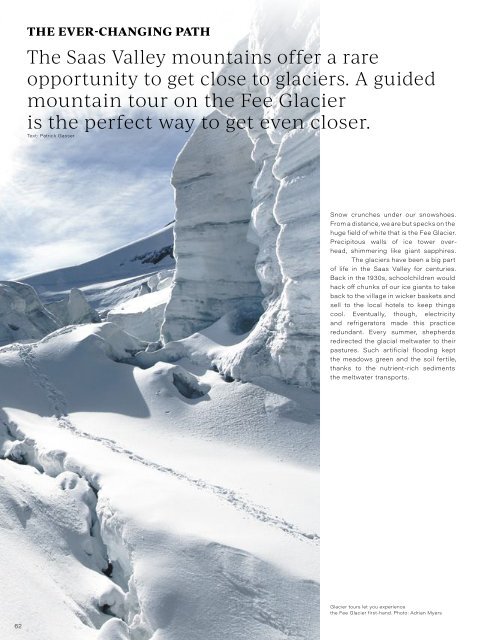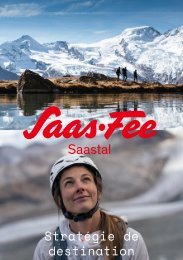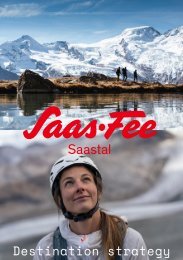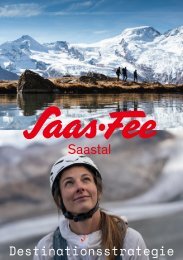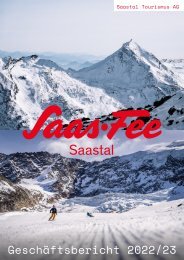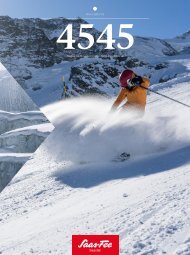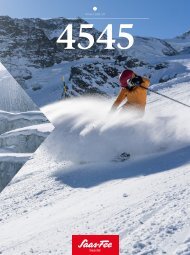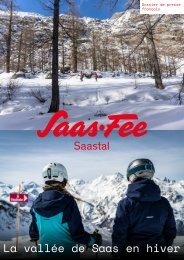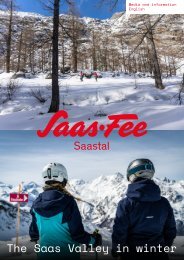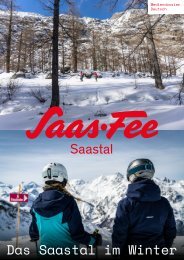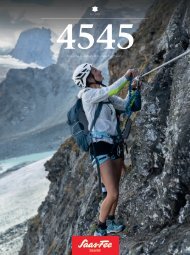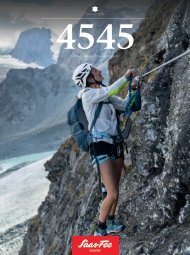You also want an ePaper? Increase the reach of your titles
YUMPU automatically turns print PDFs into web optimized ePapers that Google loves.
THE EVER-CHANGING PATH<br />
The Saas Valley mountains offer a rare<br />
opportunity to get close to glaciers. A guided<br />
mountain tour on the Fee Glacier<br />
is the perfect way to get even closer.<br />
Text: Patrick Gasser<br />
Snow crunches under our snowshoes.<br />
From a distance, we are but specks on the<br />
huge field of white that is the Fee Glacier.<br />
Precipitous walls of ice tower overhead,<br />
shimmering like giant sapphires.<br />
The glaciers have been a big part<br />
of life in the Saas Valley for centuries.<br />
Back in the 1930s, schoolchildren would<br />
hack off chunks of our ice giants to take<br />
back to the village in wicker baskets and<br />
sell to the local hotels to keep things<br />
cool. Eventually, though, electricity<br />
and refrigerators made this practice<br />
redundant. Every summer, shepherds<br />
redirected the glacial meltwater to their<br />
pastures. Such artificial flooding kept<br />
the meadows green and the soil fertile,<br />
thanks to the nutrient-rich sediments<br />
the meltwater transports.<br />
Unending fascination<br />
For the glaciers, winter is a time of rest and recovery. The meltwater<br />
that flows down from the valley via the Vispa and Rhone rivers to<br />
the Mediterranean stops flowing. Meanwhile, the snow builds up,<br />
metres deep under our snowshoes. And just as energy bars keep<br />
us going on a tour of the glacier, snow re-energizes and replenishes<br />
the glacier. Locals and guests alike remain unwaveringly fascinated<br />
with the ice world, year-round. Luckily for many, the ski slopes on<br />
the Fee Glacier remain open almost all year. As a result, Saas-Fee<br />
is one of the most important summer training bases in the world for<br />
winter sports professionals.<br />
A victim of climate change<br />
Our glacier tour takes us to the quieter parts of the glacier, away<br />
from the pistes and the usual hustle and bustle of aprés ski which<br />
is already well underway in the village below. The only sounds we<br />
can hear are our footsteps and the rhythm of our own breathing. It’s<br />
an oasis of calm at the foot of the Mischabel chain. But despite the<br />
silence, the Längfluh mountain restaurant is in sight. There, we’ll<br />
enjoy a generous Walliserteller (a selection of Valais specialities)<br />
and a refreshing glass of white wine.<br />
They’re a way of life, a vital resource, and so much more.<br />
Beyond being the much-loved subject of many a tourist’s photo,<br />
these ice giants are an indicator that our planet is warming, and fast.<br />
In the 1860s the Fee Glacier reached down into the valley, where<br />
the Felskinn cable car station sits today. Since then, the ice sheet<br />
has been disappearing. The worldwide retreat of glaciers has been<br />
accelerating in recent years. In fact, ETH Zurich‘s measurements<br />
show that during just a few weeks of the hot summers of 2017 and<br />
2018, Swiss glaciers lost as much as two to three percent of their<br />
remaining mass.<br />
For a tour please contact one<br />
of the local mountain guide offices.<br />
saas-fee.ch/bergfuehrer<br />
After a short rest, we resume our trek. A thunderous roar in the<br />
distance pierces the silence. An avalanche has been triggered<br />
by the fierce midday sun. The tumbling snow plunges down the<br />
cliffs of the Täschhorn, coming to a halt on the upper slopes of the<br />
glacier. That will nourish the glacier during the draining summer<br />
months.<br />
A formative experience<br />
The ice on the Fee Glacier is still up to 80 metres thick. It’s one<br />
of those places you can truly feel the power of nature. Mountain<br />
guides offer guided tours over the ice year-round. The starting point<br />
for these glacier explorations is at the Längfluh mountain station.<br />
And thanks to the new gondola, it only takes about 20 minutes<br />
to reach the 2,800-metre-high station from the village. Just a few<br />
metres after setting off from that point, you leave the prepared<br />
ski slopes behind. The tour leads between glistening columns of<br />
ice and over crevasses which must be carefully navigated. Many<br />
of these crevasses are more than 20 metres deep, and often, you<br />
need a trained eye to even know they’re there. This route is far too<br />
dangerous to attempt without a mountain guide.<br />
The entire group is roped together via harnesses, with the<br />
guide in the lead. Like a colourful pearl necklace, we navigate the<br />
crevasses as one. Later, at home, we spot ourselves in the images<br />
captured by Längfluh webcam. Thanks to the experience of today’s<br />
mountain guides, this trip over the Fee Glacier is accessible even<br />
for those without any prior experience. Nevertheless, the tour,<br />
which lasts approximately two hours, does require a good level of<br />
physical fitness.<br />
The glacier is constantly moving. It flows slowly but steadily<br />
downwards towards the valley. The friction that results from the<br />
ice’s movement over the rocky mountainside distorts these powerful<br />
rivers of ice, birthing deep crevasses and giant ice towers. Rarely<br />
does one feel as small as when travelling through this bizarre ice<br />
world. One thing is for sure, a journey over the Fee Glacier is an<br />
experience you’ll never forget.<br />
Glacier tours let you experience<br />
the Fee Glacier first-hand. Photo: Adrian Myers<br />
Local mountain guides lead you safely through the<br />
maze of crevasses. Photo: Stefan Kürzi for Bergwelten<br />
62<br />
63


